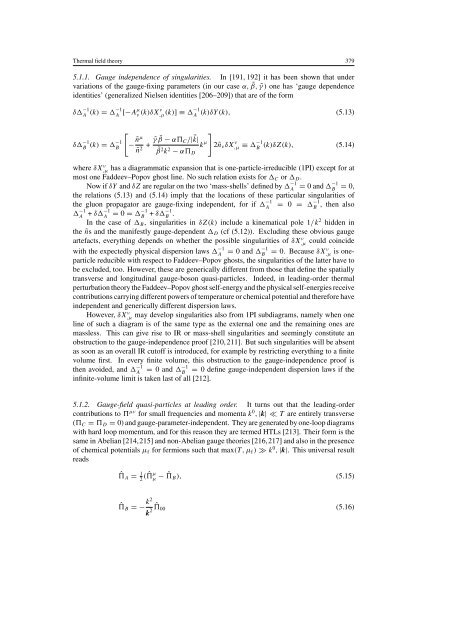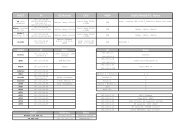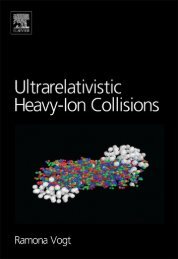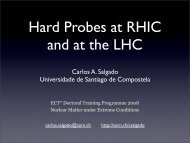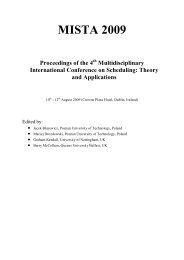Advances in perturbative thermal field theory - Ultra-relativistic ...
Advances in perturbative thermal field theory - Ultra-relativistic ...
Advances in perturbative thermal field theory - Ultra-relativistic ...
Create successful ePaper yourself
Turn your PDF publications into a flip-book with our unique Google optimized e-Paper software.
Thermal <strong>field</strong> <strong>theory</strong> 379<br />
5.1.1. Gauge <strong>in</strong>dependence of s<strong>in</strong>gularities. In [191, 192] it has been shown that under<br />
variations of the gauge-fix<strong>in</strong>g parameters (<strong>in</strong> our case α, ˜β, ˜γ ) one has ‘gauge dependence<br />
identities’ (generalized Nielsen identities [206–209]) that are of the form<br />
δ −1<br />
A<br />
(k) = −1<br />
A [−Aµ ν (k)δXν ,µ(k)] ≡ −1<br />
A<br />
(k)δY (k), (5.13)<br />
δ −1<br />
B<br />
(k) = −1<br />
B<br />
[<br />
]<br />
−ñµ<br />
ñ + ˜γ ˜β − α C /|⃗k|<br />
k µ 2ñ 2 ν δX<br />
˜β 2 k 2 ,µ ν<br />
− α ≡ −1 B<br />
(k)δZ(k), (5.14)<br />
D<br />
where δX,µ ν has a diagrammatic expansion that is one-particle-irreducible (1PI) except for at<br />
most one Faddeev–Popov ghost l<strong>in</strong>e. No such relation exists for C or D .<br />
Now if δY and δZ are regular on the two ‘mass-shells’ def<strong>in</strong>ed by −1<br />
A<br />
= 0 and −1<br />
B = 0,<br />
the relations (5.13) and (5.14) imply that the locations of these particular s<strong>in</strong>gularities of<br />
the gluon propagator are gauge-fix<strong>in</strong>g <strong>in</strong>dependent, for if −1<br />
A<br />
= 0 = −1<br />
B<br />
, then also<br />
−1<br />
A<br />
+ δ−1 A<br />
= 0 = −1 B<br />
+ δ−1 B .<br />
In the case of B , s<strong>in</strong>gularities <strong>in</strong> δZ(k) <strong>in</strong>clude a k<strong>in</strong>ematical pole 1/k 2 hidden <strong>in</strong><br />
the ñs and the manifestly gauge-dependent D (cf (5.12)). Exclud<strong>in</strong>g these obvious gauge<br />
artefacts, everyth<strong>in</strong>g depends on whether the possible s<strong>in</strong>gularities of δX,µ ν could co<strong>in</strong>cide<br />
with the expectedly physical dispersion laws −1<br />
A<br />
= 0 and −1<br />
B<br />
= 0. Because δXν ,µ is oneparticle<br />
reducible with respect to Faddeev–Popov ghosts, the s<strong>in</strong>gularities of the latter have to<br />
be excluded, too. However, these are generically different from those that def<strong>in</strong>e the spatially<br />
transverse and longitud<strong>in</strong>al gauge-boson quasi-particles. Indeed, <strong>in</strong> lead<strong>in</strong>g-order <strong>thermal</strong><br />
perturbation <strong>theory</strong> the Faddeev–Popov ghost self-energy and the physical self-energies receive<br />
contributions carry<strong>in</strong>g different powers of temperature or chemical potential and therefore have<br />
<strong>in</strong>dependent and generically different dispersion laws.<br />
However, δX,µ ν may develop s<strong>in</strong>gularities also from 1PI subdiagrams, namely when one<br />
l<strong>in</strong>e of such a diagram is of the same type as the external one and the rema<strong>in</strong><strong>in</strong>g ones are<br />
massless. This can give rise to IR or mass-shell s<strong>in</strong>gularities and seem<strong>in</strong>gly constitute an<br />
obstruction to the gauge-<strong>in</strong>dependence proof [210, 211]. But such s<strong>in</strong>gularities will be absent<br />
as soon as an overall IR cutoff is <strong>in</strong>troduced, for example by restrict<strong>in</strong>g everyth<strong>in</strong>g to a f<strong>in</strong>ite<br />
volume first. In every f<strong>in</strong>ite volume, this obstruction to the gauge-<strong>in</strong>dependence proof is<br />
then avoided, and −1<br />
A<br />
= 0 and −1<br />
B<br />
= 0 def<strong>in</strong>e gauge-<strong>in</strong>dependent dispersion laws if the<br />
<strong>in</strong>f<strong>in</strong>ite-volume limit is taken last of all [212].<br />
5.1.2. Gauge-<strong>field</strong> quasi-particles at lead<strong>in</strong>g order. It turns out that the lead<strong>in</strong>g-order<br />
contributions to µν for small frequencies and momenta k 0 , |k| ≪T are entirely transverse<br />
( C = D = 0) and gauge-parameter-<strong>in</strong>dependent. They are generated by one-loop diagrams<br />
with hard loop momentum, and for this reason they are termed HTLs [213]. Their form is the<br />
same <strong>in</strong> Abelian [214,215] and non-Abelian gauge theories [216,217] and also <strong>in</strong> the presence<br />
of chemical potentials µ f for fermions such that max(T , µ f ) ≫ k 0 , |k|. This universal result<br />
reads<br />
ˆ A = 1 2 ( ˆ µ µ − ˆ B ), (5.15)<br />
ˆ B =− k2<br />
k 2 ˆ 00 (5.16)


